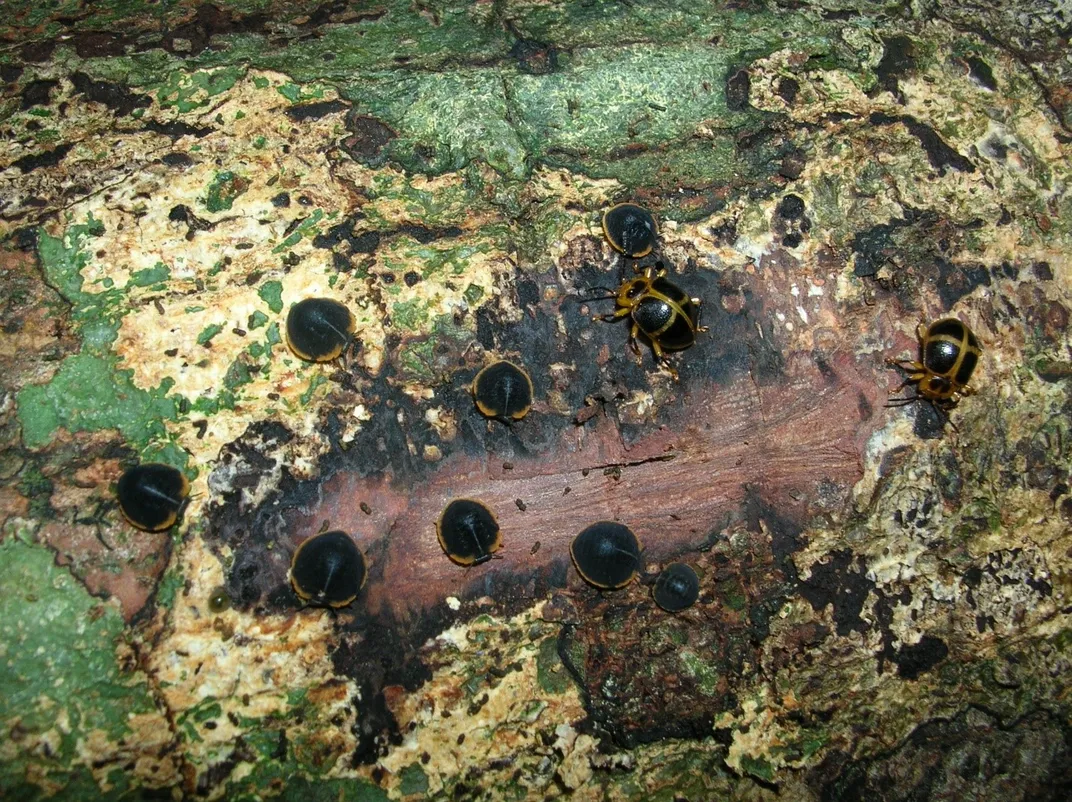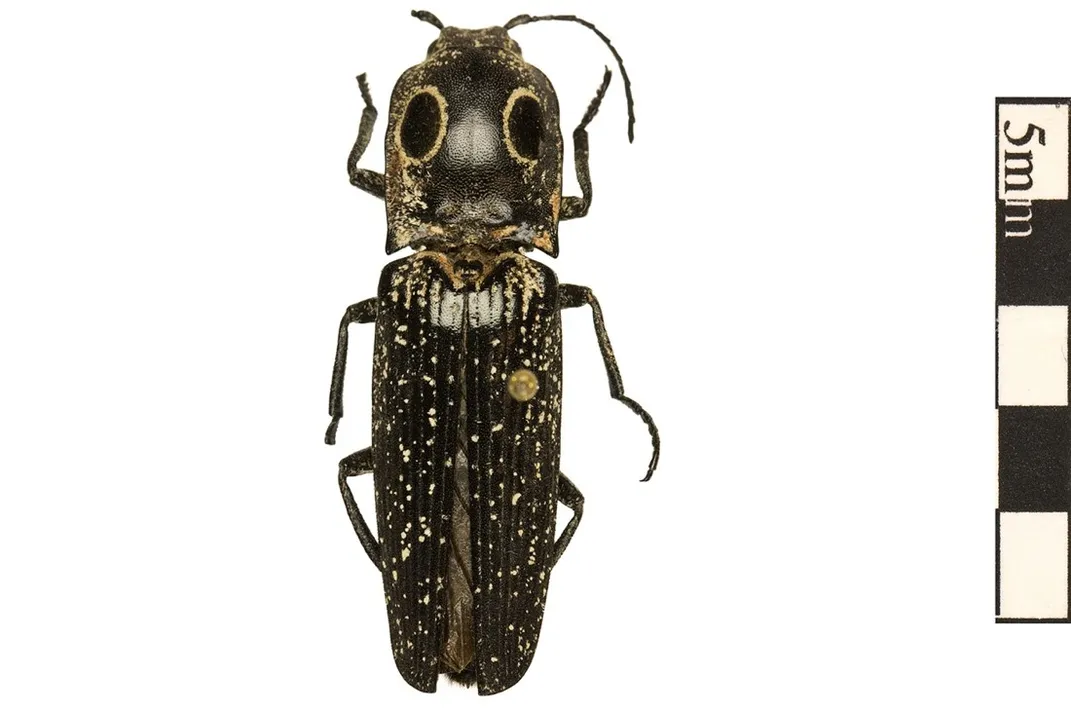NATIONAL MUSEUM OF NATURAL HISTORY
Say Hello to the Scientist Caring for Smithsonian’s 35 Million Entomology Specimens
In this Meet a SI-entist, Smithsonian Entomologist and Collections Manager Floyd Shockley reveals how insects impact our daily lives.
/https://tf-cmsv2-smithsonianmag-media.s3.amazonaws.com/blogging/featured/Person_leaning_against_an_aisle_of_cabinets_holding_preserved_insects.jpg)
Spring’s arrival comes as a welcome reprieve for those craving sunshine and warmer days. But it’s also a big deal for insects, who will surge in numbers as the temperature climbs. Some of those insects may recognize their relatives in the National Museum of Natural History, which houses over 35 million specimens in the National Entomological Collection.
For this “Meet a SI-entist,” Dr. Floyd Shockley, the collections manager in the museum’s Department of Entomology, explains the value of having so many specimens, shares his research on beetle diversity in the tropics and reveals how insects impact our daily lives.
When did you first become interested in entomology?
Although I grew up with an appreciation for nature on a small farm in rural Missouri, I didn’t really discover my interest in insects until the end of my bachelor’s when I took a couple of courses that focused on entomology. Then, between my master’s and my doctorate, I realized my real interest was in studying insect diversity and figuring out how things became the way they are now. So, I switched into systematics, which is the holistic study of diversity.
Now, I look at what species exist in a space at a particular time and how they interact with other organisms. This includes their taxonomy, which is how they are classified and related to one another, and their morphology, or what they look like. It also includes their natural history, or what they are doing in nature, and their ecology, which means what role they play in the ecosystem and how they interact with all living and non-living components.
What types of species do you focus on for your systematics research?
I’m particularly interested in the evolution of fungus-feeding beetles. Most of these beetles do not have the enzymes they need to break down fungus themselves. They have evolved complex relationships with microorganisms like yeasts that help them digest tough structures in fungus. The way each group intersects with the other has ecological importance, especially in the tropics where most of these beetles live.

Soil in the tropics is actually incredibly nutrient-poor because of plant density, which is when plants pull everything out of the soil and transport it up into the canopy. When a tree dies and falls, nutrients aren’t really redistributed until something breaks it down. For the tropics, that’s typically fungus. But fungi are problematic because they don’t move around either. So, the primary way that that tree’s nutrients get redistributed is by insects feeding off of the fungus on the tree.
What are some specimens that are now being used for research in ways that past collectors may not have expected?
One of the interesting things that has come up recently is a renewed interest in pollinators like bees. We can now use pollen stored on specimens to see what plants are associated with native bees and how that relationship has changed over time since the introduction of the European honeybee, which is used commercially to pollinate most agricultural crops in the U.S. This is all stuff that you can study that would have been difficult to study in the past because we now have the ability to analyze pollen sitting on the legs of bees in collections.
There's also been an uptick of interest in parasites and other things like bird feather mites. Scientists in the past may have missed them because they didn’t have the microscopic capabilities to even see them, or frankly they might not have been looking for them. But now we can go back and find specimens in bird feathers from over 100 years ago. We can extract them and describe them because we have better optics to allow their morphology to be seen and we know where to look for them. There are hidden gems like this being found all the time in the natural history collections of the world.
What is something most people wouldn't know about entomology?
An average person in a city might not know very much about insects other than as pests. As urbanization has happened, we get clustered more and more into cities and lose our connection to nature. Most people perceive insects as scary, but they were the first to solve many of the things that took humanity a long, long time to solve.

For example, insects were flying before anything else. They can feed on almost anything and are models for a lot of biomimicry research, acting as models for engineering, designing new materials, etc. Now, scientists are using desert beetles that have structures in their elytra — the hard coverings over their wings — that encourages water condensation from the air. They use that to gather water for drinking, and we can take that same idea and design cheap, affordable water condensation systems.
Research is being done on the physics beetles use for building new structures and engineering things. Click beetles generate an amount of force that they use to flip into the air. Analyzing that spring mechanism can help us do the same thing in robotics to design more efficient joints, airflow and aerodynamics. There are lots of ways insects benefit humanity. For any modification you can think of, insects have probably done it first. This makes them a great model for studying any sort of biological system.
What is something most people don’t know about what it’s like to work in an entomology collection?
Everything we do combines looking backward for historical context with looking forward using what we know now to predict what things may look like in the future. A collection that simply acts as a storage site for old things is a dead collection. But an active collection like ours is, by definition, a dynamic and ever-growing research tool for studying biological diversity.
/https://tf-cmsv2-smithsonianmag-media.s3.amazonaws.com/filer_public/35/53/35531907-3ce2-4d2e-b854-64f156e8e814/nineteen_preserved_insects_pinned_to_a_white_container.jpeg)
Most people think that working in an entomology collection means that you’re just pinning insects, but that’s the most basic activity we do. And even then, we’re not pinning specimens just to pin them. We do it so those specimens can be used to enhance the information we have about the entire biosphere, or all species everywhere. Also, once specimens are dead, they become very difficult to handle without damaging them, so pinning lets us move and examine the specimens without ever touching them again.
Unlike larger animals, most insects, spiders and their relatives can’t easily be identified in the field. They need to be collected and brought back to a museum, where they can be compared to other previously identified species or to be described if they are totally new to science, which happens a lot. There are 1.3 million described species of insects, arachnids and myriapods, out of an estimated 8-30 million total species. That kind of diversity and their smaller size and cryptic habits make it very difficult to know what you have until you look under a microscope.
Also, older specimens can tell us where a species was at a particular time in the past, and we can use that information to try to collect it again or figure out why it isn’t there anymore. This is important because if someone wants to do high-level genomic studies, answer evolutionary questions or talk about climate change, they might need to collect fresh material from a species. Our specimens can point to the places where that species may be based on where it has been found in the past.
In general, it’s a really exciting time to be working in a museum. We’re currently taking our specimens and making them accessible to citizen scientists, research scientists and people all over the world in a way that was never possible even a few decades ago.
Meet a SI-entist: The Smithsonian is so much more than its world-renowned exhibits and artifacts. It is a hub of scientific exploration for hundreds of researchers from around the world. Once a month, we’ll introduce you to a Smithsonian Institution scientist (or SI-entist) and the fascinating work they do behind the scenes at the National Museum of Natural History.
Related Stories:
How Tiny Wasps Became Agricultural Defenders
Family Members Follow Original Asian Giant Hornet to Smithsonian
Get to Know the Scientist in Charge of Smithsonian’s 1.9 Million Mosquitoes
Why Hawk Moths are the Underdogs of the Pollinator World
Digitization Allows Public Access to Smithsonian’s Hidden Collections

